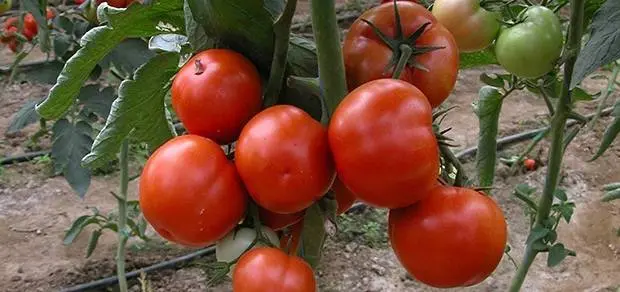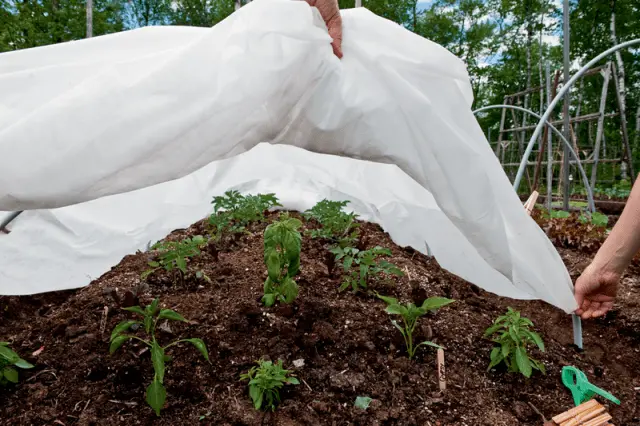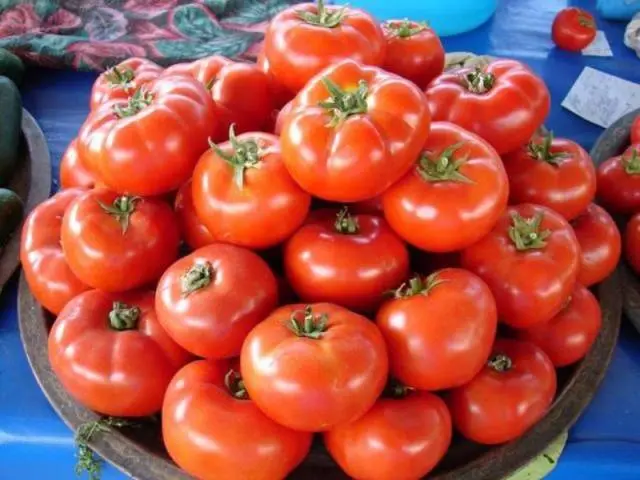Contents
To the question: “At what temperature can tomatoes be planted?” Even the most experienced gardener will not be able to give a definite answer. The thing is that the tomato is a capricious and very thermophilic culture. To calculate the timing of planting a tomato, you need to take into account a number of factors. And still, it is unlikely that you will be able to achieve an excellent result from the very first time, because growing tomatoes is a process divided into several separate stages, each of which requires adjustment of all modes, including temperature.

When it is necessary to plant tomatoes, and what these terms depend on – let’s try to figure it out in this article.
temperature groups tomato
Like any crop, tomatoes have their own growing season, which is directly related to the vegetable variety. That is why, first of all, the gardener should familiarize himself with the recommendations of the manufacturer of tomato seeds, you can find this information on a bag of seeds.

Of course, the manufacturer’s instructions are very approximate, but thanks to them, you can understand which temperature group a particular tomato variety belongs to. There are only three such groups:
- The first category includes the most cold-resistant varieties of tomatoes, which, as a rule, are tomatoes with early ripening. These crops are zoned for the climate of the northern regions, but can be used both in the middle lane and in the south of Our Country if seedlings of such tomatoes are planted earlier. So, the first group of tomato seedlings is planted in a permanent place, when the night temperature does not fall below 11 degrees, and during the day it is kept warm at 15 degrees. This planting method is good because the tomato root system can get the maximum amount of moisture left in the ground after winter. In time, this period falls approximately at the end of April – the first days of May.
- The timing of planting seedlings of tomatoes belonging to the second temperature group coincides approximately with mid-May. By this time, the region should have a night temperature of 14-15 degrees, while during the day it is recommended to warm at least 15-20 degrees. The largest part of the tomato seedlings is planted during this period, since it is considered the most favorable: the tomatoes are no longer in danger of frost, and there is still enough moisture in the ground for the development of the root system.
- Tomato seedlings planted in the ground after the thermometer has stabilized at 20 degrees belong to the third temperature group. Not all tomato varieties are able to develop normally in such conditions, because the roots no longer have enough moisture, and the sun bakes the tender leaves of young seedlings too much. In addition, late planting threatens tomatoes with various diseases and fungal infections. However, this method is suitable for the latest varieties of tomatoes. And in the northern part of the country, gardeners do not plant tomatoes in the garden before the end of May or even the beginning of June.

This significantly increases the chances of getting a good harvest, in addition, such a scheme will help determine the most favorable planting dates for a particular tomato variety in a particular region.
The dependence of the timing of planting tomatoes on the rate of ripening
Everyone knows that tomatoes are early ripening, mid-ripening and late. Such varieties have characteristic features and, of course, differ in the length of the growing season. The temperature required for normal development of tomatoes may also differ depending on the speed of their ripening.
There is a dependency here:
- Late ripe tomatoes and indeterminates (tall) tomato hybrids are sown for seedlings from 15 to 25 February. By the time the plants are transplanted, the seedlings should be about 70-80 days old, so the timing of planting them in a greenhouse or in open ground corresponds to the first decade of May.
- Varieties of tomato with medium terms ripening and the same hybrids must be sown for seedlings on March 5-10, and transferred to a permanent place somewhere around May 10-20.
- Seeds of early maturing varieties, as a rule, they are sown from March 15 to March 25, seedlings can be taken out under cover in mid-May, and in open ground – not earlier than the first days of June.

It is these indicators that are the main ones when calculating the timing of planting tomatoes.
At what temperature to plant tomatoes
The process of growing tomatoes is divided into several stages:
- preparing tomato seeds for planting;
- planting seeds for seedlings;
- dive tomato seedlings;
- hardening of tomatoes before planting in a permanent place;
- planting seedlings in open ground or in a greenhouse.
But even after all these stages, the temperature of the air and soil can significantly affect the development of tomatoes and their yield. And both too low and too high thermometer readings can be negative.

It is under such conditions that irreversible processes begin in plants, leading to the rapid death of tomatoes.
Not only critical thermometer marks negatively affect tomatoes. For example, prolonged coolness at 16 degrees during the daytime will lead to the following:
- stopping the growth of lateral shoots on the root system of a tomato;
- the impossibility of absorption of minerals and moisture by the roots;
- a decrease in the number of ovaries and a decrease in tomato yield.
Constant heat within 30-33 degrees also ends badly – tomatoes shed their leaves and flowers, which leads to zero crops.

The fight against cold is aimed at sheltering plants, so tomatoes are often grown in greenhouses, temporary greenhouses, seedlings are covered overnight with agrofiber or plastic wrap. It is also possible to prevent overheating of plants: tomatoes are shaded, the ground around the bushes is mulched to reduce the evaporation of moisture from the soil, and the bushes are often watered.
Preparing seeds and planting tomatoes for seedlings
For planting seedlings, it is necessary to purchase or collect independently high-quality planting material – tomato seeds. Before planting, the seeds are prepared in a certain way, one of the stages of preparation is the hardening of the planting material: first, the seeds are heated, then placed in the refrigerator for several days.

Proper preparation contributes to the readiness of seeds for harsh climatic conditions, seedlings obtained in this way will be able to withstand temperature fluctuations and jumps, and will better acclimatize in a new place.
After the seeds have been sown, the containers are covered with foil and placed in a warm place – tomatoes can only germinate when the air temperature is kept at 25-27 degrees.
In such conditions, you can not keep seedlings for too long – tomatoes can easily stub and die. That’s why, as soon as the first sprouts appear, the film is removed, and the containers with tomatoes are placed in a cooler, but brighter place. The temperature there is maintained at 20-22 degrees.

At this stage of development, tomato seedlings need an alternation of night and day temperatures, so at night the thermometer should show a few degrees less – a value of 16 to 18 degrees is considered optimal.
After the seedlings of the tomato have been dived, it is necessary to maintain the same temperature regime and the alternation of night and day temperatures, but at this time it is already necessary to begin to gradually harden the seedlings.
Proper hardening of tomato seedlings
Before planting a tomato in a permanent place (in a greenhouse, greenhouse or in open ground), seedlings must be hardened off.
But when buying tomato seedlings, you can never be sure that they were generally hardened.
Hardened seedlings of tomatoes are much stronger and more adaptable than usual – such tomatoes will quickly get used to the new external environment, very soon they will begin to give new shoots and roots, form ovaries and give the harvest. The probability that plants that have not been hardened will be able to take root in a new place is extremely small, this is only possible in a very warm climate and with normal humidity.

You need to start hardening seedlings of tomatoes as early as possible. Only pickled tomatoes with one or two true leaves can be safely taken out to the balcony or yard. But this is possible only in one case: if the air temperature does not fall below 15 degrees.
There is rarely such a warm spring that in late March and early April the thermometer shows more than 10 degrees in the afternoon. That’s why many summer residents and gardeners use the same greenhouses for hardening seedlings, where tomatoes will subsequently be transplanted. During the day, the air in the greenhouse warms up enough, and you can protect the plants from the cold ground by lifting them on racks or benches.

When the night frosts pass, and the air at night is warm (about 8-10 degrees), you can start the night hardening of tomato seedlings.
However, you should not put pots and boxes with plants directly on the ground, it is better to lift them on window sills or special shelves.

Therefore, this procedure should be carried out in several stages: they start with an ajar window, then they take out the seedlings for a few minutes, then they leave the tomatoes on the street for the whole day, only after that they switch to night hardening.
Moving tomato seedlings to the greenhouse
A greenhouse is needed in order to accelerate the ripening of tomatoes. After all, seedlings are transferred to protected ground much earlier than to simple beds. Polycarbonate, glass or plastic film let the sun’s rays into the greenhouse, but at the same time do not allow heat to go outside.

Thus, a certain microclimate is created inside the greenhouse, a constant temperature and humidity are maintained – all this is very useful for tomato seedlings. Under such conditions, plants develop rapidly, create ovaries and form fruits.
But, if the air in the greenhouse warms up quickly enough (already in March, the temperature may be sufficient for growing tomatoes), then the earth becomes not much warmer than that which is in simple beds.

To speed up the process of warming up the greenhouse, you can use one of the methods:
- Arrange ground heating using electricity, warm water or other energy-dependent systems.
- Raise the beds 40-50 cm from ground level, thereby protecting the tomatoes from ground frost.
- Create warm beds using the natural processes of decay and fermentation, pouring compost or humus on the bottom of the trench, and planting tomato seedlings on this layer.

When the ground in the greenhouse becomes warm (at the level of 10 degrees), you can safely plant tomatoes.
Do not forget that too hot air is detrimental to tomatoes; in order to maintain a normal microclimate, it is necessary to open the windows, use ventilation or tuck the film walls of the greenhouse.
Terms of planting tomatoes in the ground
To calculate the correct timing for planting tomatoes in the ground, as mentioned earlier, several factors must be taken into account at once. But even after that, there is a high probability of the return of cold weather, frost or other surprises from the weather.
No one is immune from mistakes, which is why experienced gardeners never plant all their tomato seedlings in one day – this process is stretched by dividing the total number of plants into several parts.

If we talk about a strip with a temperate climate, then the first batch of tomatoes is planted here at the end of April (April 20 – May 1). The largest part of the plants should be planted on average – May 1-10. And finally, tomato seedlings are planted in the middle of the month (10-20th), trying to protect at least part of the crop from possible frosts.
Due to such difficulties in the calculations, it can be recommended that summer residents record all the dates when tomatoes are sown for seedlings, dive, transferred to the ground, which is harvested – this statistics will help determine the most optimal planting dates for tomatoes in a particular locality.

All farmers strive for one thing – to grow a tomato crop as early as possible and collect a record number of fruits. The haste in this process is not connected with the gardeners’ ambitions – the earlier the tomatoes ripen, the less likely they are to get a fungal infection, suffer from pests, catch a period of intense heat or “survive” until the autumn cold.

Today there are many ways to prepare the beds, aimed at bringing tomato seedlings into the ground a little earlier. It can be:
- high beds made of wooden boards or other improvised materials;
- planting tomatoes in straw or sawdust;
- use for seedlings of individual containers (pots, buckets, boxes, bags);
- warming the earth with compost, food waste, humus or other suitable substrates;
- shelter of planted tomatoes with a film or agrofibre, used only at night or in bad weather.
Saving seedlings from frost
Despite all the precautions and complex calculations, it often happens that frosts take gardeners by surprise. And then you have to accept urgent measures to save tomato seedlings in the open field.

There can be several such ways:
- Shelter with a film or agrofibre, lutrasil, and other special fabrics. For this method, it is recommended to provide a small metal arch or frame on which covering material can be thrown so as not to damage the tomato seedlings.
- Glass jars, plastic containers, or even ordinary buckets can also protect tomatoes from freezing, but it’s not always possible to find enough dishes in sufficient quantities. This method is more suitable for small areas with a couple of dozen bushes.
- If frost threatens a large tomato plantation, you can try to heat the plants with smoke. To do this, you need to kindle a fire on the windward side. As fuel, it is necessary to use something that gives a lot of smoke: last year’s foliage, wet thick logs, tree bark, wet sawdust. Smoke will spread along the ground, thereby heating the tomatoes.
- Severe frosts can even threaten tomatoes planted in greenhouses or greenhouses. There, plants are also protected by pouring sawdust, straw on the bushes or covering them with cardboard boxes, plastic buckets, bottles.

All this helps to ensure that specific dates for planting a tomato simply do not exist. Each gardener or summer resident must determine the planting dates empirically, observing his tomatoes for several seasons in a row.
Greenhouses or greenhouses can make the process of growing a tomato a little easier, but such methods have their own characteristics. – the threat to plants is increased humidity and the likelihood of overheating due to too high temperatures and insufficient ventilation.

When dealing with tomatoes, the agrarian must understand that it will not be easy – the culture is very capricious and whimsical. But fresh tomatoes on the table and a good harvest fully pay off all the effort and money spent.









